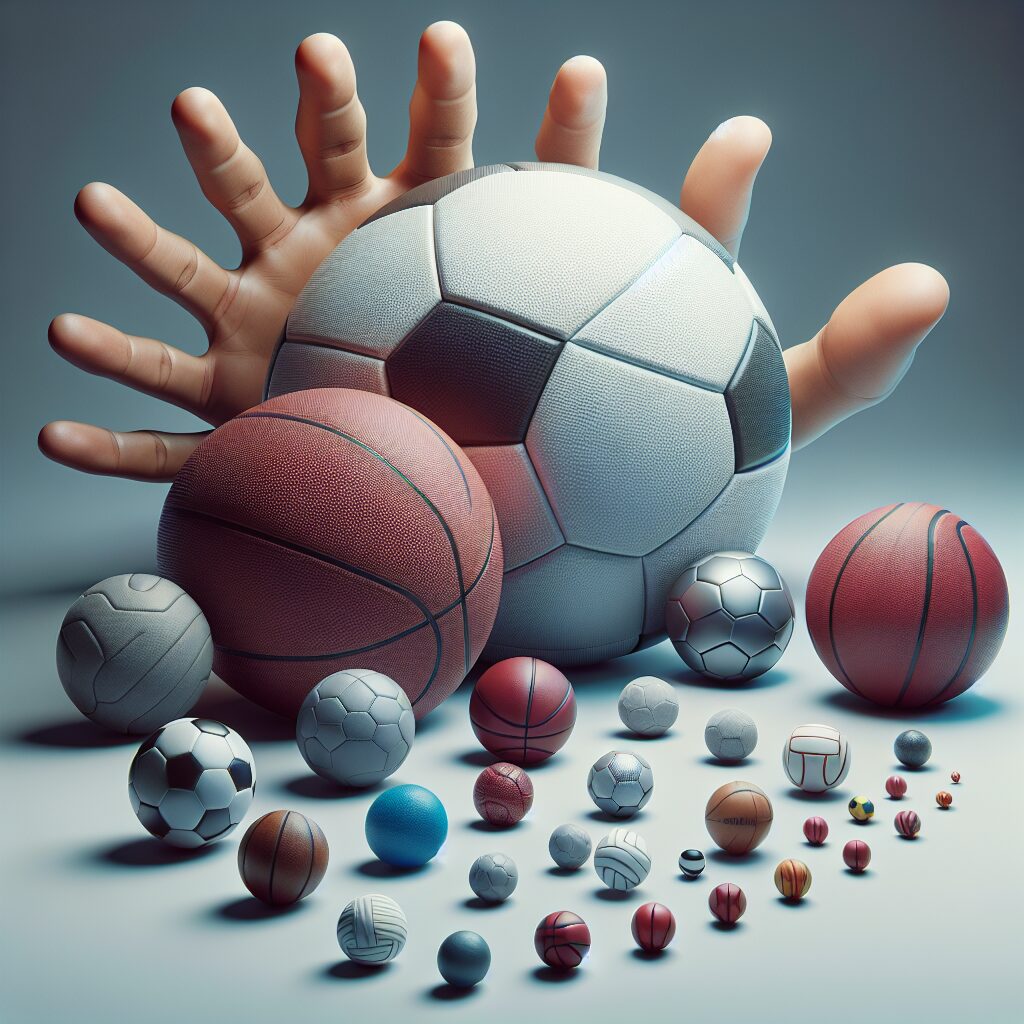Size Selection Tips: Choosing the Right Ball
When it comes to sports like basketball, soccer, or volleyball, selecting the right ball size is crucial for optimal performance and safety. But how do you determine the appropriate size? Well, it turns out that the size of the ball can have a significant impact on various aspects of the game. For instance, using a ball that is too small or too big can affect your ability to control it, lead to injury, or even result in a disadvantage during a match. In this article, we will explore some size selection tips to help you choose the right ball for your sport. So, read on to discover the key takeaways that will ensure you make an informed decision when it comes to ball size.
One of the critical factors to consider when selecting the right ball size is the age and skill level of the players. For instance, young children who are just starting to learn a sport may find it easier to handle a smaller ball due to their limited hand-eye coordination. On the other hand, professional players may prefer a larger ball to enhance their controlled passes and shots. It is also essential to take into account the specific regulations and guidelines provided by the sport’s governing bodies. For example, the NBA has guidelines for basketball ball sizes, and following these recommendations can help players perform at their best. So, as we delve into the key takeaways, keep in mind the impact of age, skill level, and official regulations on ball size selection.
Key Takeaways
1. The size of a ball is crucial for different sports and activities, as it directly affects performance, safety, and skill development.
2. Determining the appropriate ball size involves considering factors such as age, skill level, and the specific sport or activity requirements.
3. For children, selecting a ball that is too big or too small can hinder their progress and enjoyment, potentially leading to frustration and increased risk of injury.
4. Ball sizes vary across different sports and may have specific regulations depending on the age group or level of play. Researching and understanding these guidelines is essential for making the right choice.
5. Properly sized balls not only enhance performance but also help players develop fundamental skills, coordination, and confidence, leading to a better overall experience in sports and activities.
What are the best tips for choosing the right ball size?
1. Consider the purpose of the ball
When selecting a ball, it’s crucial to think about its intended use. Are you looking for a ball for a specific sport, such as soccer or basketball? Different sports have specific ball size requirements, so make sure to choose accordingly. Additionally, consider if you’ll be using the ball for casual play or competitive matches.
2. Determine the appropriate size for your age group
Age plays a significant role in selecting the right ball size. For younger kids, smaller balls are typically recommended to ensure better control and handling. As children grow older, they can progress to larger sizes that match their age and physical development. Consult size charts or guidelines specific to the sport to make an informed choice.
3. Take into account skill level and experience
The skill level and experience of the player should also influence your choice. Beginners may benefit from using slightly larger balls as they offer a larger surface area for contact, providing more forgiveness and easier ball control. Advanced players, on the other hand, might prefer using balls that meet standard size regulations to enhance their precision and performance.
4. Consider the player’s physical attributes
The body size and physical attributes of the player should be taken into consideration when selecting a ball. Taller individuals with larger hands may find it more comfortable to handle bigger balls, while individuals with smaller hands might prefer smaller balls for better grip and maneuverability.
5. Test the ball
Whenever possible, try out the ball before making a final decision. See how it feels in your hands and how it behaves when in motion. Testing the ball can give you a better understanding of its weight, bounce, and overall performance, allowing you to make an educated choice.
6. Seek expert advice
If you’re still unsure about the right ball size, don’t hesitate to seek advice from coaches, trainers, or experienced players. They can provide valuable insights and recommendations based on their expertise and knowledge of the sport.
7. Take note of safety precautions
Lastly, remember to prioritize safety when choosing a ball. Ensure that the ball is appropriate for the playing environment and follows any safety regulations set by the sport’s governing bodies. Using the correct size can help minimize the risk of injuries and ensure a more enjoyable playing experience.
Now, let’s dive into the specific ball size guidelines for different sports:
1. Soccer
In soccer, ball sizes are typically categorized based on age groups:
- Size 3: Ages 8 and under
- Size 4: Ages 8-12
- Size 5: Ages 13 and older (including adults)
2. Basketball
When it comes to basketball, the standard ball sizes are as follows:
- Size 5: Youth (ages 5-8)
- Size 6: Girls, women, and boys (ages 9-12)
- Size 7: Boys (ages 13 and older) and men
3. Volleyball
Volleyball ball sizes are generally determined by player age and gender:
- Size 5: Adults (both men and women) and boys (ages 12 and older)
- Size 4: Girls (ages 8-15) and boys (ages 8-12)
- Size 3: Boys and girls (ages 5-8)
4. Tennis
In tennis, the ball size depends on the age and skill level of the players:
- Stage 3: Red Balls (ages 8 and under)
- Stage 2: Orange Balls (ages 8-10)
- Stage 1: Green Dot Balls (ages 9-10)
- Regular: Yellow Balls (ages 11 and older)
Now, here are some tips to help you choose the right ball size:
- What are the recommended ball sizes for soccer?
- Which ball size should be used in basketball for youth?
- What is the standard ball size for volleyball in adult matches?
- What are the different tennis ball stages based on age?
- How does the player’s skill level influence ball size selection?
- Can expert advice help in choosing the right ball size?
- What precautions should be taken to ensure safety when selecting a ball?
Frequently Asked Questions
1. How do I determine the right ball size for my sport?
The ideal way to determine the right ball size for your sport is to refer to the official guidelines or regulations provided by the governing body of the sport. These guidelines usually include information on the recommended ball size based on age, level of play, and sometimes even player position.
2. Can I use the same ball size for different sports?
No, different sports have different ball sizes for a reason. Each sport has specific requirements for ball size to ensure fair play, player safety, and optimal performance. It is essential to use the appropriate ball size specified for each sport to maintain the integrity of the game.
3. Is it crucial to consider the player’s hand or body size when selecting a ball?
Yes, player’s hand or body size plays a significant role in determining the suitable ball size. A ball that is too large or too small can affect the player’s grip, control, and overall performance. It is advised to choose a ball size that feels comfortable and allows for proper handling and maneuverability.
4. Can I rely solely on age recommendations to select the right ball size?
While age recommendations are a good starting point, they should not be the sole factor in determining the right ball size. Factors such as skill level, playing position, and physical abilities should also be considered. It is better to consult specific size charts or guidelines provided by sports equipment manufacturers or experts for more accurate sizing.
5. Are there any indicators that the ball size I have chosen is incorrect for me?
Yes, there are a few indicators that suggest the ball size you have chosen might be incorrect. If you struggle to maintain control over the ball, have difficulty in gripping it, experience discomfort during play, or notice a significant decrease in performance, it might indicate the need for a different ball size.
6. Can I adjust the inflation level of the ball to compensate for size differences?
Minor adjustments to the inflation level can sometimes help in achieving a better fit, especially if you are between two sizes. However, it is crucial to note that altering the inflation level cannot compensate for a significant difference in ball size. It is always recommended to select the right ball size from the beginning.
7. What should I do if I cannot find the recommended ball size for my sport?
If you cannot find the recommended ball size, it is advisable to contact the governing body of the sport or consult with a reputable sports equipment retailer. They can provide recommendations or suggest suitable alternatives that comply with the standards of the game.
8. Should I opt for a heavier or lighter ball if I want to improve my skills?
The weight of the ball should align with the specified guidelines for your sport. While training with a heavier or lighter ball can be beneficial for certain drills or specific skill development, it is important to primarily focus on mastering the techniques with the appropriate ball weight to ensure a seamless transition during actual games or competitions.
9. How frequently should I replace my ball?
The lifespan of a ball depends on various factors such as the quality of materials used, frequency of use, playing environment, and maintenance. It is advisable to inspect the ball regularly for signs of wear, such as cracks, tears, or loss of shape. Generally, a ball should be replaced if it no longer meets the required standards or exhibits significant signs of deterioration.
10. Can I mix different ball sizes during a game or practice session?
No, it is not recommended to mix different ball sizes during a game or practice session. Uniformity in ball size ensures fair play and consistent performance for all players. It is essential to use the same ball size for everyone involved in the activity.
Final Thoughts
Choosing the right ball size is crucial for enhancing performance, ensuring player safety, and maintaining the integrity of the game. By carefully considering factors such as sport-specific guidelines, player body size, and skill level, you can make an informed decision when selecting a ball. Remember, it’s not just about age recommendations; the right ball size should feel comfortable, allow for proper control, and contribute to an enjoyable playing experience.
Additionally, periodically reassessing the appropriateness and condition of your chosen ball and seeking expert advice when needed will help you stay on top of your game. By prioritizing proper ball sizing, you are setting yourself up for success and maximizing your overall sporting experience.




